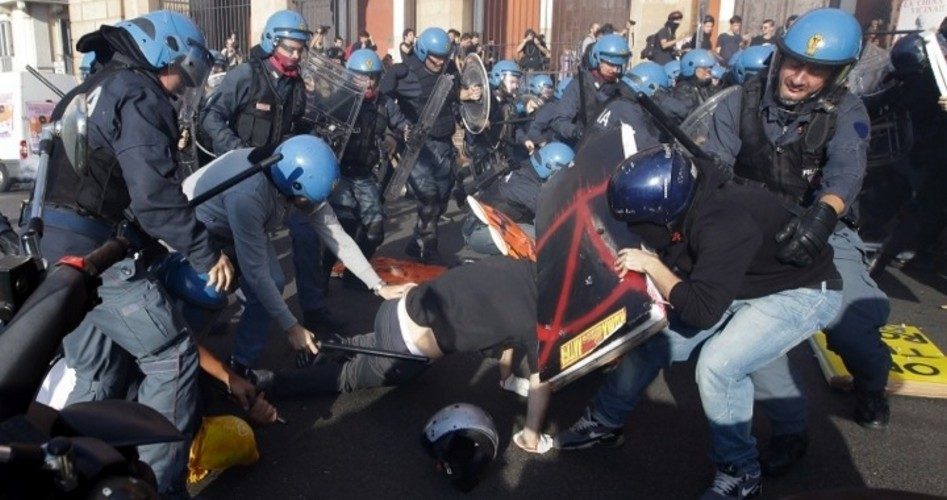
Across Europe this week, an unprecedented and well-coordinated series of transnational mass strikes and protests led largely by Big Labor took to the streets in major European capitals and cities to demand an end to so-called “austerity” policies – mostly government spending cuts. In many cases, the massive demonstrations turned violent.
Analysts, however, say the seemingly spontaneous chaos may actually have been orchestrated by forces behind the scenes. Indeed, much of the media focus was on the relatively new phenomenon of so-called “pan-European” action, with labor leaders and activists framing the conflict as a regional European Union struggle rather than separate national efforts to influence domestic policy.
From Spain, Portugal, Italy, and Greece to France and even Germany, millions of workers and union leaders representing virtually every sector of the economy in the EU joined forces on Wednesday. The mass action was, according to organizers at least, an effort to stop budget cuts and labor reforms that policy makers across the continent say are necessary to stave off an even deeper economic crisis.
“There is a social emergency in the south,” claimed Secretary General Bernadette Segol with the European Trade Union Confederation, which played a large role in orchestrating the cross-border unrest throughout much of the region. “All recognize that the policies carried out now are unfair and not working.”
Another official with the ETUC, representing nearly 90 groups across Europe, echoed those remarks but went even further. “The people of Europe will not stand for fiscal fundamentalism and will fight for an alternative based on social and economic justice,” said General Secretary Designate Frances O’Grady. “‘Those in the corridors of power in Brussels and Frankfurt need to understand this — that if ordinary European workers feel that the EU is about little more than cuts, open markets and privatization, then the European project will collapse just as surely as night follows day.”
From the United Kingdom, protest leaders also emphasized the supposed need to join forces internationally as part of what analysts said was a push to further empower transnational institutions. “Coalition of Resistance” organizer Andrew Burgin, for example, was quoted as saying that the mass demonstrations would “forge links across Europe, showing Britain’s austerity struggles as part of a pan-European, international movement.”
Burgin, who organized a rally outside of the European Commission’s offices in London, also blasted government efforts to rein in budget deficits and wild spending. “They’ve only just started cuts but they are pretty draconian already,” he was quoted as saying. “I think this is the beginning of a new movement. It will be a day remembered in history as the beginning of a pan-European movement, possibly an international movement, against capitalism.”
With unemployment now above 25 percent, Spanish labor bosses called the second general strike in less than a year, organizing giant protests in cities across the country. Transportation, energy, businesses, schools, construction, health care, and more were brought almost to a standstill as outraged workers took to the streets. Unions claimed more than 75 percent of the labor force went on strike.
Organizers in Barcelona reported over a million protesters in the city, though officials gave far smaller figures. In Madrid, meanwhile, union bosses said some 350,000 people had gathered to speak out. Dozens of police officers were injured in clashes with violent mobs around the country and over 100 demonstrators were arrested.
“We have never seen an international strike with unions across borders fighting for the same thing — it’s not just Spain, not just Portugal, it’s many countries demanding that we change our structure,” far-left Spanish Congressman Alberto Garzón with the United Left party was quoted as saying. “It’s important to understand this is a new form of protest.”
In neighboring Portugal, where unemployment is also high and surging, the situation was similar, with one of the nation’s two largest unions calling on its members to strike. Public transportation ground to a virtual halt as hundreds of flights out of Lisbon were cancelled. Hospitals operated with minimal staff and trash was left uncollected across the country. Dozens of Portuguese cities saw protests of varying sizes.
Italy also suffered from significant and violent unrest in numerous cities and towns, with tens of thousands of union members and students attacking riot police, according to news reports. A few police were reportedly injured while dozens of protesters were detained.
Greece, likely the hardest hit economy in Europe, has been plagued by violent riots for years now, and those continued this week. In one of the most alarming developments, furious Greeks in the city of Thessaloniki assaulted the German consul on Thursday while chanting “kick the Nazis out.”
There were reportedly smaller “symbolic” protests in Germany, which has thus far fared much better than its southern European counterparts and is currently funding massive bailouts across the region. However, German policy makers insisted that austerity must go on regardless of the mass demonstrations throughout the EU.
“We must nevertheless do what is necessary: break open encrusted labor markets, give more people a chance to work, become more flexible in many areas,” said German Chancellor Angela Merkel, who is pushing hard for a plan that would give unelected EU bosses the power to veto national governments’ budgets. “We will of course make this clear, again and again, in talks with the unions.”
While the protests were largely framed as a sort of spontaneous uprising and a coming together of big government-promoting forces across Europe, experts said the real story is not quite that simple. It is true that with political power shifting at breakneck speed toward Brussels, much of the activism has also started taking aim at the EU. But critics believe the real organization is taking place out of the limelight in a very deliberate and methodical way.
Analysts for the liberty-oriented Daily Bell, for example, speculated that the mass strikes and protests may have been what are known as a “false flags” — operations intended to deceive the public regarding who is actually behind an event or movement. The purpose, according to the analysis, would be to further the goals of an elite group of establishment power-brokers seeking to smash national sovereignty and eventually build a world government.
“One would have to be very naive to believe that the unions and their leaders were not part of this larger ‘directed history,’ as we call it,” the analysts wrote in a piece entitled Union Strikes Are Likely More EU False Flags published this week. “The idea that the union movement has not been co-opted — its leaders, anyway — is a silly one. The rank-and-file may believe, but leaders know the truth and operate as politicians do. They line their own pockets and try to stay out of the headlines.”
According to the Daily Bell, the true purpose behind the orchestrated unrest is evident if one understands the larger dialectic at work. The unions, the analysts said, are being used to co-opt real social action, which could eventually lead to even greater efforts to disband the emerging EU super-state while encouraging true reforms toward liberty, honest money, and national sovereignty.
“The unions also look toward big government (and maybe the EU itself) for redress of grievances stemming from austerity. This has the effect of damping down the secession movement and cultural identity, which are on the upswing,” the free market-oriented analysts explained. “For this reason we don’t put much faith in these big protests. In fact, it begins to look as if the chief reason for austerity was to provide justification for pan-European ‘union’ protests, thus cementing internationalism rather than tribal identity as the dominant ‘people’s voice’ of the EU.”
Meanwhile, as the unrest continues to spiral out of control in much of southern Europe, the Eurozone economy is still sliding deeper into turmoil. Mega banks and bloated governments are seeking bailouts and the European Central Bank has stepped up its highly controversial monetary programs. Unemployment is still on the rise.
But while the EU itself seems to be coming apart at the seams, high-ranking officials from Brussels to most European capitals are working fiendishly to finish off what little remains of national sovereignty by exploiting the crisis. Eventually, as former Maoist revolutionary and current EU Commission President José Manuel Barroso admitted recently, the goal is to create a full-blown “federation.”
Photo of protesters and riot police clashing in Rome, Italy, during strikes over EU austerity measures: AP Images
Alex Newman, a foreign correspondent for The New American, is currently based in Europe. He can be reached at [email protected].
Related articles:
Spain’s Unemployment Rate Rises to One in Four
Lithuanian Austerity Prime Minister Loses Election
European Central Bank President Buys Government Bonds But Warns of Deflation
Swiss Military Preparing for EU Meltdown Scenario
EU in Final Phase of Destroying Democracy, Czech President Warns
UK Leader in European Parliament Says EU on the Verge of Cataclysm
German High Court Approves Step Toward European Dictatorship
Lisbon Treaty Builds EU Super-state
One Euro, One Europe, One Mounting Mess
Nobel Peace Prize for the EU: Far-Left Politics Behind the Scenes
Germany’s Merkel Calls for EU Veto Power Over National Budgets



